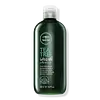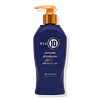What's inside
What's inside
 Key Ingredients
Key Ingredients

No key ingredients
 Benefits
Benefits

 Concerns
Concerns

 Ingredients Side-by-side
Ingredients Side-by-side

Water
Skin ConditioningSodium Laureth Sulfate
CleansingSodium Lauryl Sulfate
CleansingCocamide Mipa
EmulsifyingParfum
MaskingCocamidopropyl Betaine
CleansingPanthenol
Skin ConditioningMelaleuca Alternifolia Leaf Oil
AntioxidantMenthol
MaskingHedychium Coronarium Flower/Leaf/Stem Extract
Skin ConditioningTriticum Vulgare Germ Oil
EmollientAlgae Extract
EmollientSimmondsia Chinensis Leaf Extract
HumectantAloe Barbadensis Leaf Extract
EmollientAnthemis Nobilis Flower Extract
MaskingRosmarinus Officinalis Leaf Extract
AntimicrobialGlycerin
HumectantOleamidopropyl Betaine
CleansingPropylene Glycol
HumectantGlycol Stearate
EmollientPEG-150 Distearate
EmulsifyingCitric Acid
BufferingTetrasodium EDTA
Polyquaternium-7
Bisamino PEG/PPG-41/3 Aminoethyl Pg-Propyl Dimethicone
PEG-12 Dimethicone
Skin ConditioningMethylchloroisothiazolinone
PreservativeMethylisothiazolinone
PreservativeMagnesium Chloride
Magnesium Nitrate
Limonene
PerfumingLinalool
PerfumingCitronellol
PerfumingCI 42090
Cosmetic ColorantCI 19140
Cosmetic ColorantWater, Sodium Laureth Sulfate, Sodium Lauryl Sulfate, Cocamide Mipa, Parfum, Cocamidopropyl Betaine, Panthenol, Melaleuca Alternifolia Leaf Oil, Menthol, Hedychium Coronarium Flower/Leaf/Stem Extract, Triticum Vulgare Germ Oil, Algae Extract, Simmondsia Chinensis Leaf Extract, Aloe Barbadensis Leaf Extract, Anthemis Nobilis Flower Extract, Rosmarinus Officinalis Leaf Extract, Glycerin, Oleamidopropyl Betaine, Propylene Glycol, Glycol Stearate, PEG-150 Distearate, Citric Acid, Tetrasodium EDTA, Polyquaternium-7, Bisamino PEG/PPG-41/3 Aminoethyl Pg-Propyl Dimethicone, PEG-12 Dimethicone, Methylchloroisothiazolinone, Methylisothiazolinone, Magnesium Chloride, Magnesium Nitrate, Limonene, Linalool, Citronellol, CI 42090, CI 19140
Cyclopentasiloxane
EmollientDimethiconol
EmollientHydrolyzed Keratin
HumectantPrunus Amygdalus Dulcis Oil
Skin ConditioningMauritia Flexuosa Fruit Oil
Skin ConditioningCinnamidopropyltrimonium Chloride
Argania Spinosa Kernel Oil
EmollientIsohexadecane
EmollientAlpha-Isomethyl Ionone
PerfumingPolysilicone-15
UV FilterKeratin Amino Acids
Skin ConditioningOenothera Biennis Oil
EmollientSesamum Indicum Seed Oil
EmollientParfum
MaskingLinalool
PerfumingHexyl Cinnamal
PerfumingButylphenyl Methylpropional
PerfumingHydroxyisohexyl 3-Cyclohexene Carboxaldehyde
MaskingCitronellol
PerfumingLimonene
PerfumingBenzyl Benzoate
AntimicrobialCyclopentasiloxane, Dimethiconol, Hydrolyzed Keratin, Prunus Amygdalus Dulcis Oil, Mauritia Flexuosa Fruit Oil, Cinnamidopropyltrimonium Chloride, Argania Spinosa Kernel Oil, Isohexadecane, Alpha-Isomethyl Ionone, Polysilicone-15, Keratin Amino Acids, Oenothera Biennis Oil, Sesamum Indicum Seed Oil, Parfum, Linalool, Hexyl Cinnamal, Butylphenyl Methylpropional, Hydroxyisohexyl 3-Cyclohexene Carboxaldehyde, Citronellol, Limonene, Benzyl Benzoate
 Reviews
Reviews

Alternatives
Ingredients Explained
These ingredients are found in both products.
Ingredients higher up in an ingredient list are typically present in a larger amount.
Citronellol is used to add fragrance/parfum to a product. It is often derived from plants such as roses. In fact, it can be found in many essential oils including geranium, lavender, neroli, and more. The scent of Citronellol is often described as "fresh, grassy, and citrus-like".
Since the Citronellol molecule is already unstable, Citronellol becomes irritating on the skin when exposed to air.
Citronellol is a modified terpene. Terpenes are unsaturated hydrocarbons found in plants. They make up the primary part of essential oils.
Citronellol is not able to be absorbed into deeper layers of the skin. It has low permeability,
Citronellol is also a natural insect repellent.
Learn more about CitronellolLimonene is a fragrance that adds scent and taste to a formulation.
It's found in the peel oil of citrus fruits and other plants such as lavender and eucalyptus. The scent of limonene is generally described as "sweet citrus".
Limonene acts as an antioxidant, meaning it helps neutralize free radicals.
When exposed to air, oxidized limonene may sensitize the skin. Because of this, limonene is often avoided by people with sensitive skin.
The term 'fragrance' is not regulated in many countries. In many cases, it is up to the brand to define this term. For instance, many brands choose to label themselves as "fragrance-free" because they are not using synthetic fragrances. However, their products may still contain ingredients such as essential oils that are considered a fragrance.
Learn more about LimoneneLinalool is a fragrance and helps add scent to products. It's derived from common plants such as cinnamon, mint, citrus, and lavender.
Like Limonene, this ingredient oxidizes when exposed to air. Oxidized linalool can cause allergies and skin sensitivity.
This ingredient has a scent that is floral, spicy tropical, and citrus-like.
Learn more about LinaloolParfum is a catch-all term for an ingredient or more that is used to give a scent to products.
Also called "fragrance", this ingredient can be a blend of hundreds of chemicals or plant oils. This means every product with "fragrance" or "parfum" in the ingredients list is a different mixture.
For instance, Habanolide is a proprietary trade name for a specific aroma chemical. When used as a fragrance ingredient in cosmetics, most aroma chemicals fall under the broad labeling category of “FRAGRANCE” or “PARFUM” according to EU and US regulations.
The term 'parfum' or 'fragrance' is not regulated in many countries. In many cases, it is up to the brand to define this term.
For instance, many brands choose to label themselves as "fragrance-free" because they are not using synthetic fragrances. However, their products may still contain ingredients such as essential oils that are considered a fragrance by INCI standards.
One example is Calendula flower extract. Calendula is an essential oil that still imparts a scent or 'fragrance'.
Depending on the blend, the ingredients in the mixture can cause allergies and sensitivities on the skin. Some ingredients that are known EU allergens include linalool and citronellol.
Parfum can also be used to mask or cover an unpleasant scent.
The bottom line is: not all fragrances/parfum/ingredients are created equally. If you are worried about fragrances, we recommend taking a closer look at an ingredient. And of course, we always recommend speaking with a professional.
Learn more about Parfum